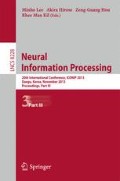Abstract
Home robotics is a continuously growing field in academic research as well as commercial market. People are becoming more interested in advanced intelligent robots that can do housework and take care of children and elderly. A brain-inspired intelligent system is a possible solution to make the robot capable of learning and predicting risks at home. In order to solve difficult problems such as ambiguous situations and unclear causality, we propose a robotic system inspired from human working memory functions, which consists of an Event Map for storing observed information, and a Causality Map for representing causal relationships through supervised learning. The two maps couple together to enable the robot to evaluate various situations based on the appropriate context. More importantly, the Causality Map takes into account the dynamical aspects of physical attributes (e.g. the decreasing temperature of a hot pot). Our case studies showed that this is a satisfactory solution for predicting many risky situations at home.
Access this chapter
Tax calculation will be finalised at checkout
Purchases are for personal use only
Preview
Unable to display preview. Download preview PDF.
References
Gates, B.: A robot in every home. Scientific American 296(1), 58–65 (2007)
Lovgren, S.: A Robot in Every Home by 2020, South Korea Says. National Geographic News (September 2006)
Kaneko, R., Ishikawa, A., Ishii, F., Sasai, T., Iwasawa, M., Mita, F., Moriizumi, R.: Population projections for Japan: 2006-2055, outline of results, methods, and assumptions. The Japanese Journal of Population 6, 76–114 (2008)
Nagaraja, J., Menkedick, J., Phelan, K.J., Ashley, P., Zhang, X.L., Lanphear, B.P.: Deaths from residential injuries in US children and adolescents, 1985-1997. Pediatrics 116, 454–461 (2005)
Granger, C.W.J.: Investigating causal relations by econometric models and cross-spectral methods. Econometrica 37(3), 424–438 (1969)
Winkler, R.L.: Introduction to Bayesian Inference and Decision, 2nd edn. Probabilistic Publishing (2003)
LeDoux, J.: The Emotional Brain: The Mysterious Underpinnings of Emotional Life. Simon & Schuster Ltd. (1996)
Janowsky, J.S., Shimamura, A.P., Squire, L.R.: Source memory impairment in patients with frontal lobe lesions. Neuropsychologia 27, 1043–1056 (1989)
Wunderlich, K., Beierholm, U.R., Bossaerts, P., O’Doherty, J.P.: The human prefrontal cortex mediates integration of potential causes behind observed outcomes. Journal of Neurophysiology 106, 1558–1569 (2011)
Buehner, M., Krumm, S., Pick, M.: Reasoning = working memory ≠ attention. Intelligence 33, 251–272 (2005)
McCarthy, J., Patrick, H.: Some Philosophical Problems from the Standpoint of Artificial Intelligence. Machine Intelligence 4, 463–502 (1969)
Hilborn, R.C.: Sea gulls, butterflies, and grasshoppers: A brief history of the butterfly effect in nonlinear dynamics. American Journal of Physics 72(4), 425–427 (2004)
Schyns, P.G., Goldstone, R.L., Thibaut, J.-P.: The development of features in object concepts. Behavioral and Brain Sciences 21, 1–54 (1998)
Zhang, W., Linden, D.J.: The other side of the engram: experience-driven changes in neuronal intrinsic excitability. Nature Review Neuroscience 4, 885–900 (2003)
Modis, T.: The normal, the natural, and the harmonic. Technological Forecasting and Social Change 74(3), 391–398 (2007)
Carvalho, J.P., Tomé, J.A.B.: Rule based fuzzy cognitive maps - fuzzy causal relations. In: CIMCA 1999 - Computational Intelligence for Modelling, Control and Automation, Viena, Austria (March 1999)
Author information
Authors and Affiliations
Editor information
Editors and Affiliations
Rights and permissions
Copyright information
© 2013 Springer-Verlag Berlin Heidelberg
About this paper
Cite this paper
Chik, D., Tripathi, G.N., Wagatsuma, H. (2013). A Method to Deal with Prospective Risks at Home in Robotic Observations by Using a Brain-Inspired Model. In: Lee, M., Hirose, A., Hou, ZG., Kil, R.M. (eds) Neural Information Processing. ICONIP 2013. Lecture Notes in Computer Science, vol 8228. Springer, Berlin, Heidelberg. https://doi.org/10.1007/978-3-642-42051-1_5
Download citation
DOI: https://doi.org/10.1007/978-3-642-42051-1_5
Publisher Name: Springer, Berlin, Heidelberg
Print ISBN: 978-3-642-42050-4
Online ISBN: 978-3-642-42051-1
eBook Packages: Computer ScienceComputer Science (R0)

